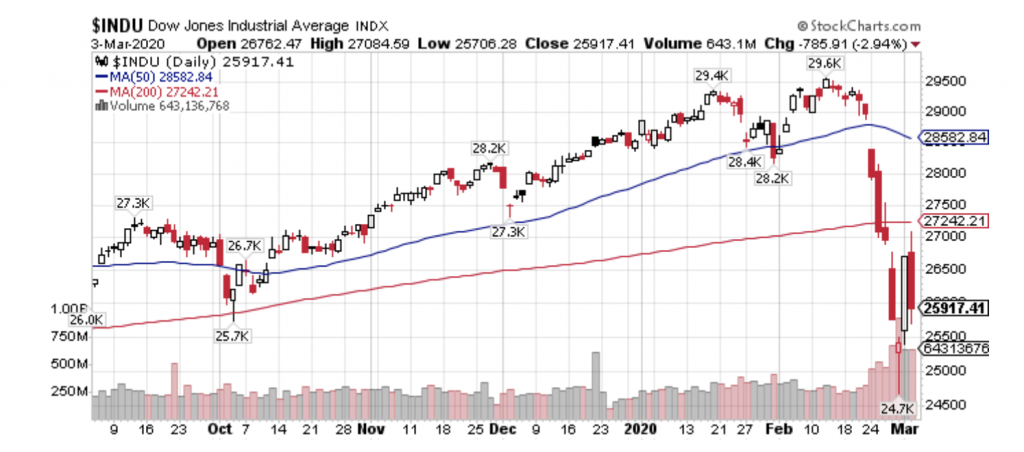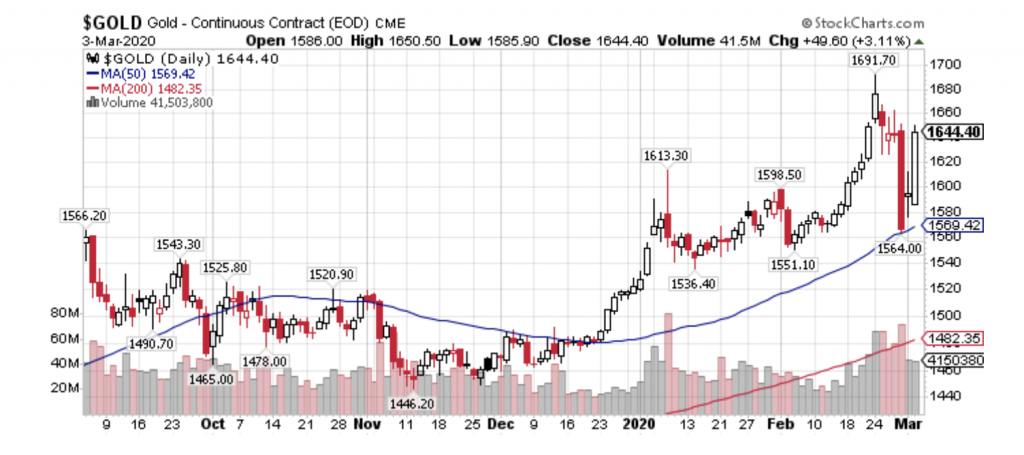
Market Mayhem: A Close Look at the Fed Policy Responsible For It!

The Fed cut interest rates. Stocks fell. Gold climbed.
In an unscheduled emergency meeting Tuesday, the nation’s central bank cut the benchmark federal funds rate by a half-point to a range of 1%-1.25%. It cut the discount rate as well.
It made the moves in response to COVID-19, the Coronavirus.
Stocks fell. The Dow lost almost 800 points.
Gold rocketed $43 higher.
It makes perfect sense. In the last two weeks, the Dow has plunged below both its long-term and short-term moving averages, both of which have rolled over and turned down (the blue and red lines respectively on the following charts).

Gold, on the other hand, is above both trend lines. Both trend lines are moving up. And even in the face of margin-call selling of gold by stock traders that we wrote about last Friday was not enough to break support at the short-term trend line. (“Traders in markets with perfectly sound economic fundamentals can sometimes liquidate their positions in other things to meet margin calls in collapsing markets. It appears that in the general carnage of the stock market, large investors scrambling for cash to meet margin calls took profits in gold, the most liquid commodity of all.” From our 2/29 commentary “What the Historic Wall Street Tumble Means for Precious Metals”)

We believe that Fed policy will mean still lower stock prices. And much higher gold. In this commentary, we would like to share with you why this is so.
We might as well start with the C-virus. People everywhere are wondering about the coronavirus and asking the same thing: How bad will it get?
We wonder as well, but since there is little we can do about the public health impact, we confine most of our thoughts to the financial impact it will have.
As far as that goes, the handwriting is already on the wall. Wherever the medical calamity ends up on a scale of 1 to 10, from mild to unrestrained tragedy, the markets have made clear that the stocks cannot weather the storm, while gold continues to provide shelter like nothing else.
There are people in high places watching just as intently as we are, and though they have no more medical skills to bring to bear on the crisis than do we, they have intervened with more interest rate manipulation, nonetheless.
“The U.S. economy remains strong. However, the coronavirus poses evolving risks to economic activity. The Federal Reserve is closely monitoring developments…” So said Fed chairman Jay Powell. That was before the Tuesday rate cut.
The Fed is always “monitoring the situation.” It is always “keeping a close watch on conditions.”
For all that monitoring and watching, what can it actually do about what it sees? Let’s take it from the beginning.
Prosperity is the result of production. Cars, food, consumer goods, energy, clothes, entertainment, personal and professional services. Wealth is the increase in these things. Does the Fed produce any of these things?
No. It can only print more money and credit. And the creation of money and credit is not the creation of actual wealth.
In fact, the Fed’s creation of more money and credit – by pouring money into the repo markets, or printing money to drive rates down – can temporarily inflate financial markets, but ultimately only lessens the value of the money you already have.
Seriously, if the Fed can plan and create economic outcomes, why exactly have we had the worst economic dislocations in the country’s history under its regime? The Great Depression. The Great Recession. A housing bust that saw millions lose their homes. The destruction of the dollar’s purchasing power. Weak economic growth. $23 trillion dollars in federal debt. As much as ten times that hidden debt. A stalled-out middle class. A widening wealth gap.
Is it possible that the Fed planned and created these outcomes intentionally? Or is it more likely that the Fed created these consequences by failing to understand the fundamentals of markets and prices, of production and consumption? Created them with a fantasy-land misunderstanding of its own ability to affect the interactions of hundreds of millions of producers far-flung across the country and around the world with its constant interventions, meddling in rates, bailing out reckless banks, and destroying the price discovery function of markets?
Columnist and best-selling author John Tammy points out that Fed stimulus is no different than another government spending “that shrinks the supply of resources that would otherwise be made available to private sector producers.
“The Fed can only act insofar as the private sector creates resources that economic actors would seek in the marketplace, so ‘policy action’ by the Fed is by definition intervention on the part of non-market actors that pushes resources to where they wouldn’t otherwise go in a free economy helpfully free of government meddlers. Just as government spending happens to the detriment of private investment, production, and growth, so do Fed or central bank machinations take place at the expense of private, market-disciplined lending and investment, production, and growth. In short, the [Fed] intervention called for… will almost as a rule blunt any recovery from COVID-19.”
There is no question the coronavirus is suppressing economic activity. But will you be more willing to go gambling in a palatial Singapore casino with the Fed’s lowering of the fed funds and discount rates? More willing to fly to Korea or Italy? Or even fly domestically? Will Chinese suppliers of essential industrial parts and electronics in areas hard hit by the C-virus suddenly go back to work producing goods needed by foreign manufacturers now that the Fed has lowered rates?
“We do recognize a rate cut will not reduce the rate of infection, it won’t fix a broken supply chain. We get that,” said Powell. “But we do believe that our action will provide a meaningful boost to the economy.”
It will certainly provide a boost to prices. It shrinks the supply of resources in the productive economy, as Tammy describes. At the same time, following David Stockman, we might point out that the breakdown of global supply chains means higher production costs “… via a lot more cost (for inventories, second suppliers, shorter supply lines etc.,) and a lot less profit.”
At the same time, monetary policy dilutes the value of every other dollar in existence.
Economist Robert Wenzel summed up Fed policy this way: “Money supply growth has been extraordinarily strong in recent months and this Fed action will result in even stronger money growth—which will add to the upward pressure on prices that has been slowly developing.”
So the Fed has driven stocks down. And gold up.
More of the same is in the offing.
